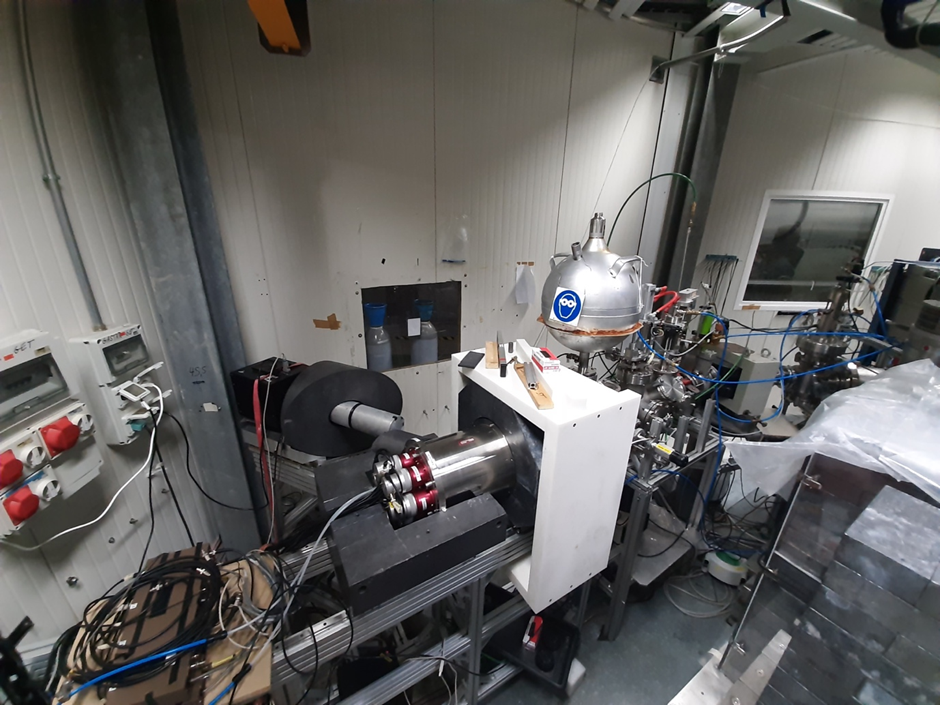
Ai Laboratori Nazionali del Gran Sasso, la collaborazione LUNA ha recentemente ottenuto un importante risultato per la comprensione delle Stelle Giganti Rosse, riproducendone le condizioni stellari in laboratorio. Le misure condotte hanno infatti permesso di determinare con maggiore accuratezza le abbondanze relative ai due isotopi stabili del carbonio in queste stelle, stabilendo nuovi valori di riferimento.
L’articolo che descrive la ricerca è stato pubblicato oggi sulla rivista internazionale Physical Review Letters (“Proton-capture rates on carbon isotopes and their impact on the astrophysical 12C/13C ratio” - https://journals.aps.org/prl/abstract/10.1103/PhysRevLett.131.162701).
In natura esistono due tipi di atomi stabili di carbonio, il 12C e il 13C. Nelle rocce terrestri si trova 1 atomo di 13C ogni 100 atomi di 12C, mentre negli esseri viventi il 13C è più abbondante.
La sintesi degli elementi chimici come il carbonio avviene all’interno delle stelle.
Il ciclo Carbonio-Azoto-Ossigeno (CNO), proposto da Hans Bethe nel 1938, spiega come una stella più massiccia del Sole produca, attraverso alcune reazioni di fusione nucleare, l’energia necessaria al suo sostentamento. In alcune stelle note come giganti rosse, ad esempio Arturo, la quarta stella più brillante del cielo, il 13C è significativamente più abbondante, presentando 11 atomi di 13C ogni 100 di 12C .
Risolvere il mistero dell’origine della vita passa anche attraverso la comprensione dei processi che determinano il rapporto 12C e 13C in natura.
Riproducendo in laboratorio le reazioni dei primi due processi del ciclo CNO (12C+p→13N e 13C+p→14N) la collaborazione LUNA ha misurato la probabilità con cui queste reazioni avvengono nelle stelle, determinando il rapporto dei due atomi stabili del carbonio nelle stelle giganti. Con i nuovi risultati le abbondanze degli isotopi 12C e 13C risultano del 25% e del 30% più basse di quelle utilizzate oggi nei modelli stellari.
“Le caratteristiche di bassissimo fondo dei Laboratori del Gran Sasso, unitamente all’esperienza quasi trentennale della collaborazione LUNA di misurare con estrema precisione i processi di interesse astrofisico - commenta Gianluca Imbriani, Università di Napoli Federico II, Spokesperson della collaborazione LUNA - hanno portato a questo straordinario risultato. Abbiamo aggiunto un altro importante tassello alla comprensione delle giganti rosse”.
LUNA (Laboratory for Underground Nuclear Astrophysics) è una collaborazione scientifica internazionale composta da circa 50 ricercatori, afferenti ai Laboratori Nazionali del Gran Sasso, alle sezioni INFN e le università di Bari, Genova, Milano Statale, Napoli Federico II, Padova, Roma Sapienza, Torino, all’Osservatorio di Collurania dell’ Istituto Nazionale di Astrofisica; al Helmholtz-Zentrum Dresden-Rossendorf (Germania), alla School of Physics and Astronomy dell’Università di Edimburgo (Regno Unito), all’ATOMKI e al Konkoly Observatory (Ungheria).
Ulteriori informazioni sulla collobarazione LUNA sono disponbili al sito http://luna.lngs.infn.it
English version
At the Gran Sasso National Laboratory, the LUNA collaboration has recently obtained important results for the understanding of red giant stars, reproducing stellar conditions in the laboratory. The measurements conducted have in fact made it possible to determine with greater accuracy the relative abundances of the two stable isotopes of carbon in these stars, establishing new reference values. A paper describing the research was published today in the international journal Physical Review Letters (“Proton-capture rates on carbon isotopes and their impact on the astrophysical 12C/13C ratio” – https://journals.aps.org/prl/abstract/10.1103/PhysRevLett.131.162701).
In nature there are two types of stable carbon atoms, 12C and 13C. In terrestrial rocks, 1 atom of 13C is found for every 100 atoms of 12C, while 13C is more abundant in living beings.
The synthesis of chemical elements such as carbon occurs inside stars. The Carbon-Nitrogen-Oxygen (CNO) cycle, proposed by Hans Bethe in 1938, explains how a star more massive than the Sun produces the energy necessary for its sustenance through nuclear fusion reactions. In some stars known as red giants, for example Arcturus, the fourth brightest star in the sky, 13C is significantly more abundant, having 11 atoms of 13C for every 100 atoms of 12C.
Solving the mystery of the origin of life also involves understanding the processes that determine the 12C and 13C ratio in nature.
By replicating in the laboratory the reactions of the first two processes of the CNO cycle (12C+p→13N and 13C+p→14N), the LUNA collaboration measured the probability for these reactions to occur in stars, and determined the ratio of the two stable atoms of carbon in giant stars.
Results reveal abundances of 12C and 13C isotopes which are 25% and 30% lower than those used today in stellar models.
“The very low background characteristics of the Gran Sasso Laboratories, together with the almost thirty-year experience of the LUNA collaboration in measuring processes of astrophysical interest with extreme precision - comments Gianluca Imbriani, Spokesperson of the experiment - have led to this extraordinary result, we added another important piece in the understanding of red giants."
LUNA (Laboratory for Underground Nuclear Astrophysics) is an international scientific collaboration comprising approximately 50 researchers from Italy (Gran Sasso National Laboratories, the INFN sections and the Universities of Bari, Genoa, Milano Statale, Napoli Federico II, Padua, Roma Sapienza, Turin, the Collurania Observatory of the National Institute of Astrophysics), Germany (Helmholtz-Zentrum Dresden-Rossendorf), Hungary (ATOMKI and Konkoly Observatory), and the United Kingdom (University of Edinburgh).
Further information on the LUNA collaboration can be found at: http://luna.lngs.infn.it














